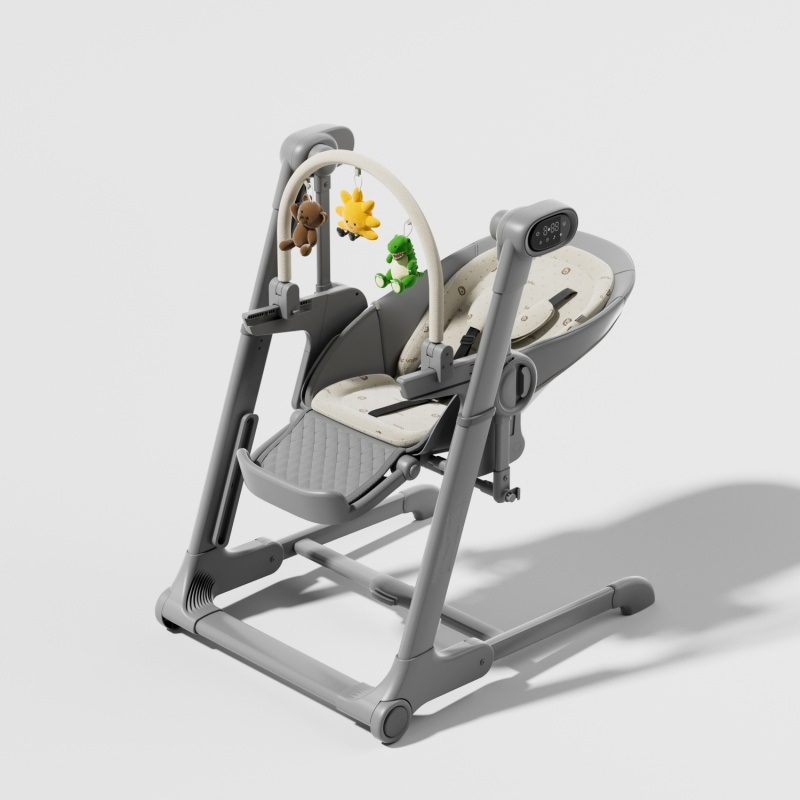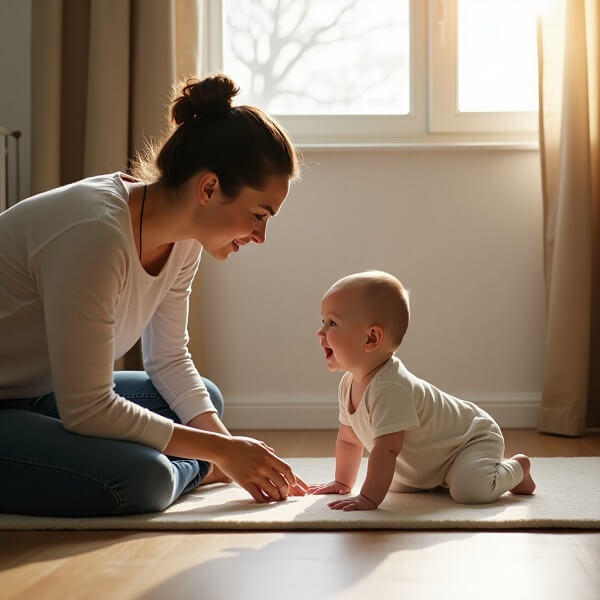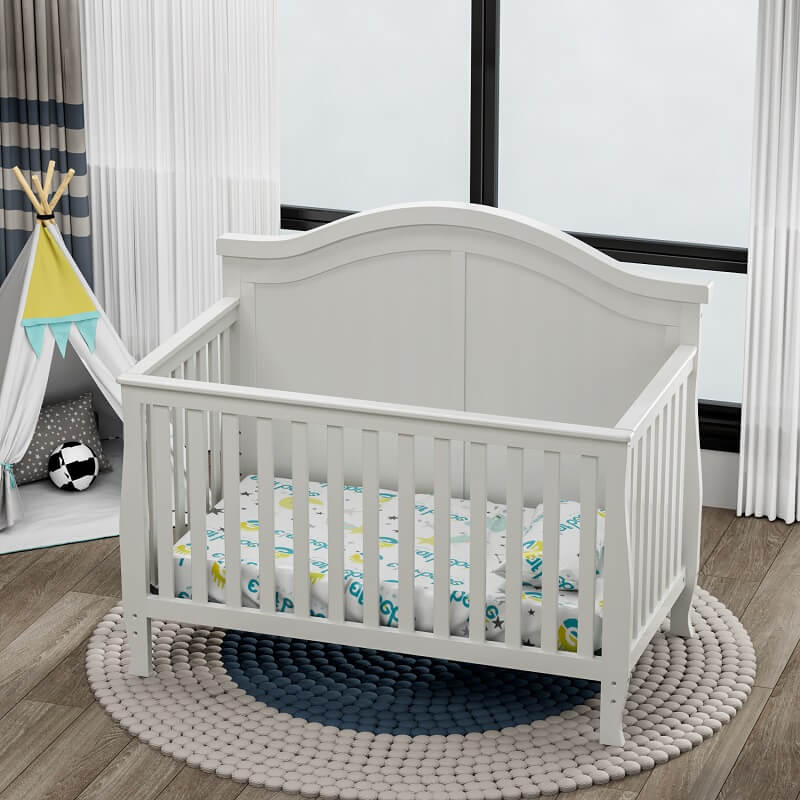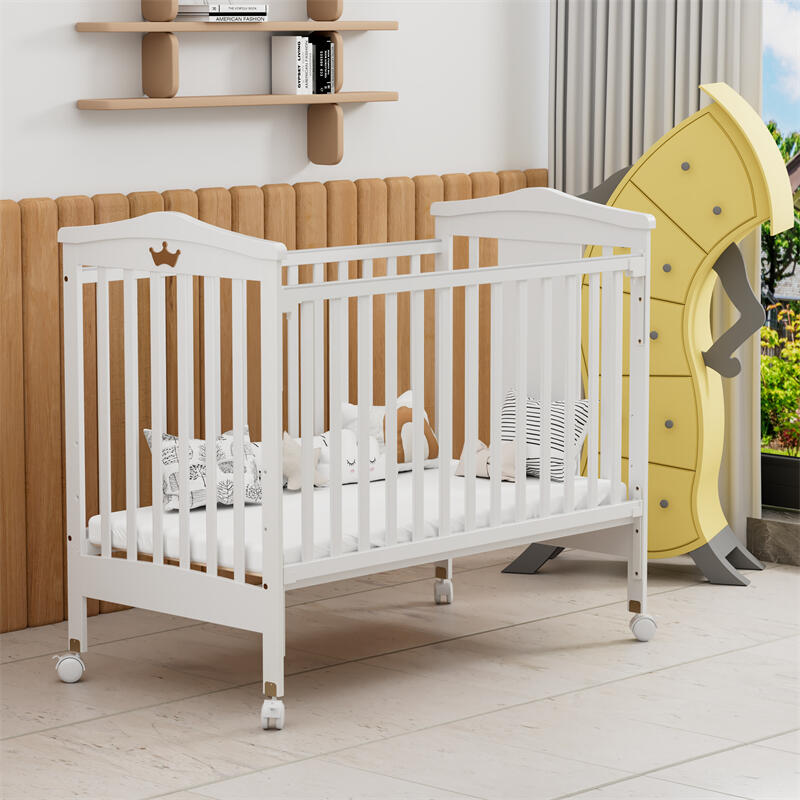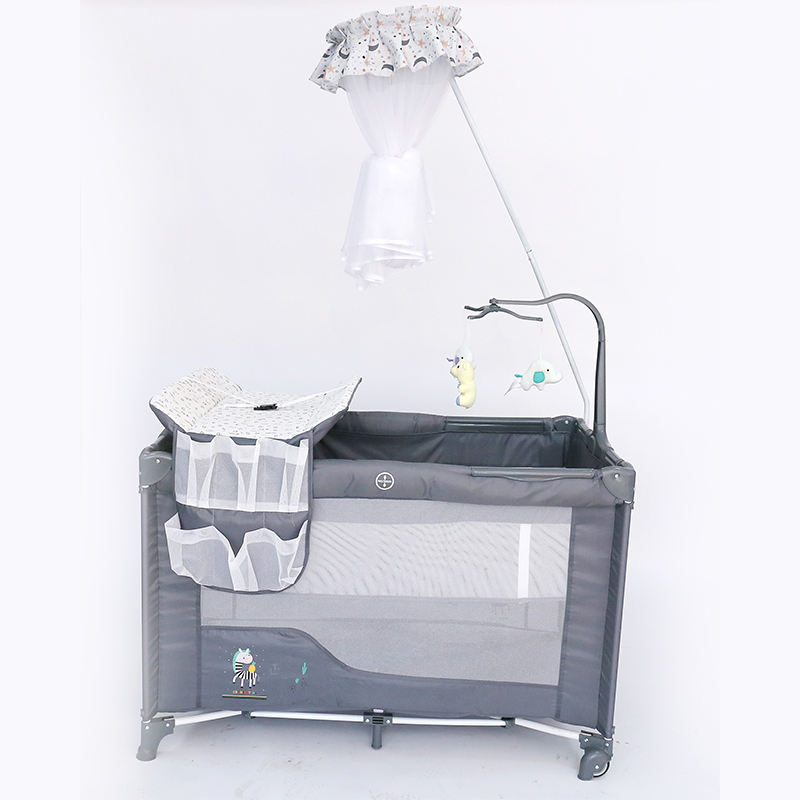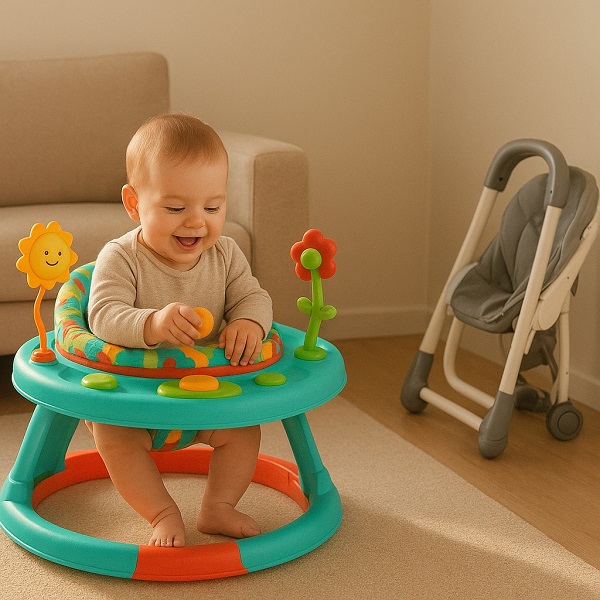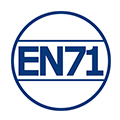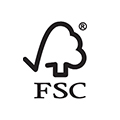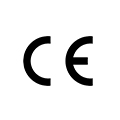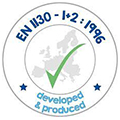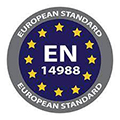According to pediatric guidelines, a high chair is a critical tool to support children from birth up to 3 years old (or roughly 40 lbs / 18 kg). While standard models typically start at 6 months، أ reclining high chair extends this safe use period by 4–6 months, making it the superior long-term gear solution.
Unlike traditional models, a reclining high chair has multiple angles. This means it can safely support an infant who cannot yet hold their head up or sit on their own.
This guide is your complete, trustworthy handbook, written by experts in early childhood gear. We will walk through exactly how these versatile chairs work, the benefits for your baby’s digestion and development, and the top features to look for when choosing a safe, long-term solution.
What Is a Reclining High Chair and How Does It Work?
أ reclining high chair is an essential piece of baby gear. It is designed to offer a safe, comfortable, and adjustable seating option for babies from birth up to toddler age. The key difference is the adjustable backrest. This function allows the chair to move from an upright sitting position to a gentle angle. Some models even offer a nearly flat lay-back position, making them perfect for a reclining high chair for newborns.
At its heart, a reclining high chair is a versatile, long-term investment. It adapts as your baby reaches different milestones. Its main components are similar to a standard high chair but include a critical mechanical system:
- Adjustable Backrest: The core feature. It moves the seat back into several fixed positions.
- Recline Mechanism: Usually a button, lever, or handle located on the back or side of the seat. It allows parents to smoothly change the angle.
- Five-Point Safety Harness: Always included, this is essential for keeping a baby secure in any position, especially when reclined.
- ارتفاع قابل للتعديل: Most good models let you adjust the overall height. This lets the chair fit different table heights, from the kitchen counter to the dining table.
How the Recline Mechanism Works?
The reclining feature is not just about comfort; it is about safety. When a baby is very young and cannot support their head, they need a semi-reclined position. This position prevents their head from slumping forward, which can block their airway.
The mechanism is simple for parents but highly secure. You usually press a button, which releases a safety lock. You then gently push the backrest to the desired angle. Once you release the button, the lock snaps back into place. Always check for that audible click. That “click” is your sign that the chair is safely locked.
What Are the Benefits of a Reclining High Chair for Babies?
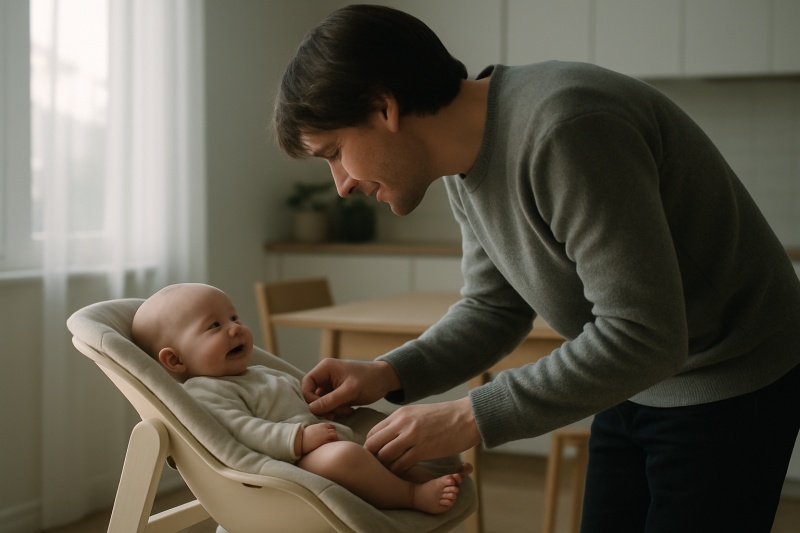
Choosing baby gear often comes down to finding tools that simplify your life while giving the best for your baby. A reclining high chair offers more than just a place to sit; it is a key piece of early development support. Here are the most valuable benefits:
Fostering Inclusion and Connection
This is a big one for new parents. A reclining high chair allows your baby to join the family activities long before they can sit at the table. Imagine being able to have your little one safely reclined at the counter height while you prepare dinner. Or, having them right next to the dining table during meals.
Being included in family life helps babies feel secure and connected. They hear conversations, see facial expressions, and start learning about social cues. You do not have to put your baby down in a separate room or on the floor. They are always in sight and at a comfortable height for interaction.
Digestive and Respiratory Support
Sometimes, the simplest angle change can make a huge difference in your baby’s comfort. For babies dealing with common digestive issues like Gastroesophageal Reflux (GER or Reflux), a semi-upright position is crucial.
Pediatric experts often suggest that keeping a baby slightly elevated after feeding can help reduce the symptoms of reflux. The gentle recline of the high chair is perfect for this. When they are slightly elevated, gravity helps keep stomach acids down. It also helps babies who are congested or sick to breathe more easily than lying completely flat.
Extended Lifespan and Value
A standard high chair is typically used for 12–18 months. In contrast, a reclining high chair can serve your family from day one, often lasting up to 3 years. While the initial cost may be 30%–50% higher (e.g., $200 vs $150), it replaces the need for a separate newborn bouncer or lounger (a saving of roughly $80–$150), making it a smarter financial decision over the product’s full lifecycle.
When Can a Baby Use a Reclining High Chair?
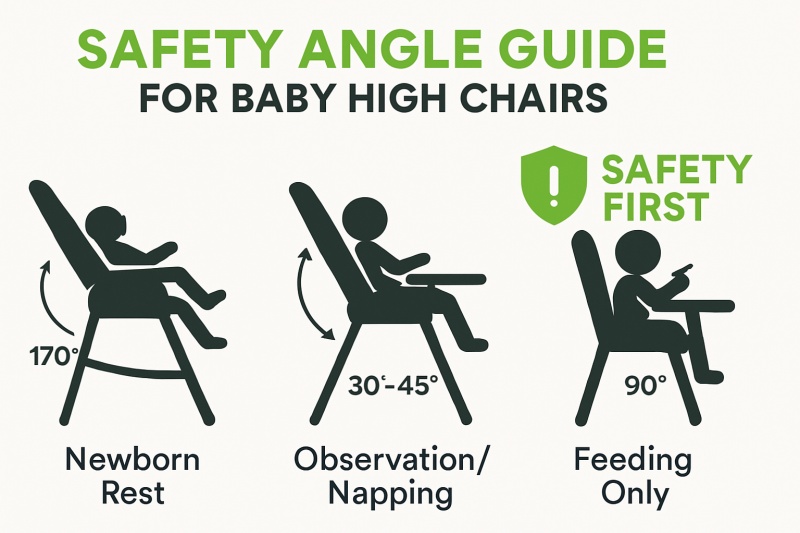
This question is at the top of every new parent’s mind. The short answer is: almost immediately, but the way you use it changes as your baby grows. It is vital to match the chair’s function to your baby’s developmental milestones.
A reclining high chair is one of the few baby items you can start using right away if it is approved for newborns.
- Newborn Stage (0–3 Months): Use the deepest recline setting. At this stage, the chair acts as a safe, elevated nest. It is for resting and observing, NOT for feeding.
- Active Stage (3–6 Months): Your baby is more alert. You can use a more upright recline for playtime or to watch you in the kitchen.
The most important milestone is when your baby is ready to start solid foods. This is when the chair moves to its full, upright purpose. Before you ever place food on the tray, your baby must meet two key safety requirements, as advised by pediatricians:
- Head Control: Your baby can hold their head up steadily without wobbling.
- Sitting Support: They can sit with minimal support, usually around 6 months.
Never start solids while your baby is in a reclined position. Reclining for feeding greatly increases the risk of choking. Once they are ready for food, the high chair must be upright, at a 90-degree angle, to protect their airway.
Types of Reclining High Chairs
Reclining high chairs come in different shapes and sizes to fit every family’s needs and space. Knowing the main types helps you choose the one that works best for your home and lifestyle.
Standard Freestanding High Chairs
These are the classic, full-sized models. They are often the most adjustable, offering the widest range of height and recline settings. They are very sturdy and usually come with wheels for easy movement.
The pros are maximum stability, the most comfortable padding, and large trays. The cons are that they take up a good amount of floor space and can be difficult to store.
Space-Saving and Booster Seats
If you live in a smaller home or if you simply do not want a large piece of gear standing around, these are a great choice. These models usually attach securely to a regular dining chair. They still offer the recline feature you need for a younger baby, but they can be easily stored in a closet. Space-saving reclining high chair models are often a favorite in apartments.
Modular and Convertible Systems
These systems are designed for long-term use. They often start as a full high chair. Later, they can be broken down into a separate small table and chair set, a toddler seat, or even a simple booster seat. This type offers the best value, as one purchase covers many years of your child’s growth.
Why choose a كرسي مرتفع قابل للتحويل? They reduce clutter and adapt to your child’s needs without you needing to buy new gear every year. They are a smart, long-term investment for the modern family.
For example, brands like Clafbebe specialize in designing modular baby furniture systems that prioritize easy cleaning and quick, tool-free assembly. By offering products with these practical advantages, they ensure that the furniture is a solution, not a hassle.
Top 5 Features to Look For When Buying
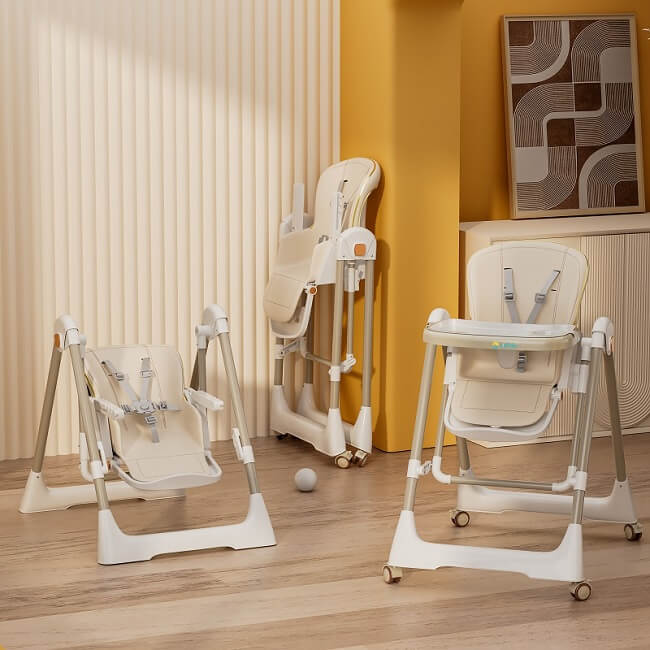
When you are ready to buy, it is easy to get lost in all the options. Focus on these five key features to make sure you are choosing a safe, functional, and long-lasting high chair.
The Recline Range and Positions
Check how many recline positions the chair offers. The best models offer 3 to 5 angles. Make sure the deepest angle is suitable for your baby’s age. If you plan to use it for a newborn, the angle should be very slight (almost flat) to support the baby’s spine and airway.
Safety and Stability
Always look for products certified by JPMA (Juvenile Products Manufacturers Association) or ASTM, ensuring compliance with the highest standards. The base must be wide and sturdy, with the industry-standard tipping angle of 10 degrees or more to prevent falls. A five-point harness is mandatory.
سهولة التنظيف والصيانة
Parenting is messy, and high chairs get very messy! This is often the number one complaint from parents. A good high chair should have:
- Dishwasher-Safe Tray: A tray that pops off easily and can go right into the dishwasher.
- الأسطح القابلة للمسح: The seat pad should be made of a waterproof, easily wipeable material.
- Seamless Design: Check for gaps, crevices, or fabric folds where crumbs can get trapped and mold can grow. Minimal seams mean easier cleaning.
Height and Footrest Adjustability
Adjustable height encourages positive feeding habits by bringing the baby to the table. [Pediatric Occupational Therapist Insight]: Crucially, check the footrest. A solid, adjustable footrest is non-negotiable for safe feeding. As OTs frequently point out, when a baby’s feet are firmly supported, their core and trunk stability is maximized.
This “feet-grounded” feeling helps improve concentration during meals, minimizes fidgeting, and provides the necessary foundation for fine motor control development.
Foldability and Mobility
If space is tight, look for a chair that folds flat quickly. Even if you have plenty of room, the ability to fold it up and roll it out of the way is a huge plus. Some chairs have lockable wheels, which are great for moving the chair but can be locked down during feeding for safety.
Reclining High Chair vs. Standard High Chair
Making the choice between a reclining model and a standard one often depends on two factors: your budget and your timing. If you are buying before the baby arrives, the versatility of the reclining chair is hard to beat. If you are waiting until your baby is six months old and sitting up, a standard chair might suffice.
To help you decide, here is a quick comparison of the key differences:
| ميزة | Reclining High Chair | Standard High Chair |
| Suitable Age | From Newborn (with deep recline) to Toddler | From 6 Months (when baby can sit unassisted) to Toddler |
| Functionality | Multi-functional: Resting, Observation, Feeding | Single-purpose: Feeding only (Upright) |
| Price & Value | Higher initial cost, but better long-term value (Extended usage) | Lower initial cost, but shorter usage lifespan |
| Space Footprint | Usually larger, with more features, sometimes foldable | Varies, but often simpler and more compact |
| Safety Note | Must use the harness even in recline. NEVER feed while fully reclined. | It must be used only when the baby can fully sit up. |
Choosing the reclining option is often a way to simplify the amount of baby gear you own. It replaces the need for a separate baby bouncer or lounger in the kitchen, combining multiple needs into one reliable, secure piece of furniture.
What is the best recline angle for feeding?
This is a critical safety question for all parents transitioning to solids. Despite the name, a reclining high chair’s recline function is not meant for feeding. The key rule is simple: when feeding solids, the chair must be completely upright at a 90-degree angle.
When a baby is reclined, gravity works against the swallow. This increases the risk that food or liquid will go down the wrong pipe, leading to choking or aspiration. You need your baby to be fully supported, sitting straight up, with their hips, knees, and ankles all supported (this is why the footrest is so important).
- 90 Degrees: This is the best recline angle for actively spoon-feeding purees or for baby-led weaning. It is the safest position for your baby’s airway.
- Slight Adjustments: A very slight tilt (maybe $5^\circ$ to $10^\circ$) can sometimes be acceptable if it is the chair’s most upright setting, but $90^\circ$ is always the goal.
- The Danger Zone: Angles of $45^\circ$ or more are strictly for resting, observation, and comfort—never for feeding.
Always wait until your baby can sit unassisted before introducing solids. Proper positioning prevents a higher risk of choking, making the feeding experience safer and less stressful for everyone.
خاتمة
A reclining high chair is one of the smartest, most versatile purchases you can make for your new family. It is a piece of furniture that grows with your baby, safely offering a place for them from day one to the toddler years.
When you are making your final choice, remember the core message of this guide: Safety, Adjustability, and Cleaning Ease. Look for that reliable five-point harness, the sturdy base, and the simple, wipeable design.
By choosing a high-quality, multi-functional system—like those designed by companies focused on professional, hassle-free solutions, such as Clafbebe’s modular systems—you are investing in more than just a seat.

